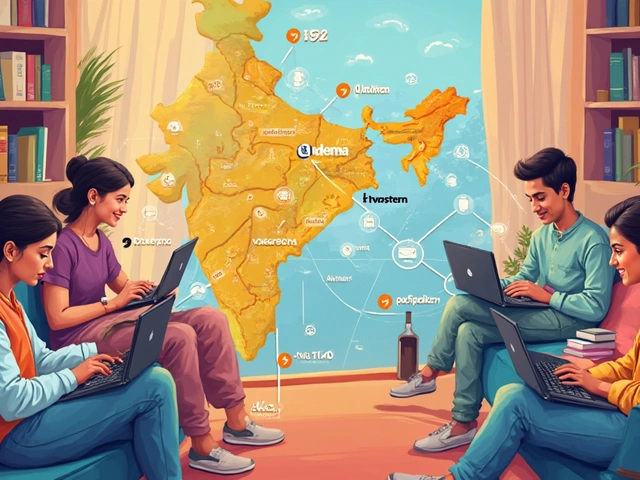Ever wondered why your neighbourhood tuition centre struggles for space while kids in the next city are acing maths through their phones? eLearning systems have quietly transformed what it means to go to school, prep for a new job, or simply master English grammar, all without stepping out of your room. There’s no limit to who can join these digital classrooms: teenagers in Mumbai, nurses in Chennai, even retired uncles in Pune hankering for history courses. If you think eLearning just means watching pre-recorded videos, think again. What powers these platforms and makes them tick? What’s the real deal behind “eLearning systems” and why should you pay attention?
What Exactly is an eLearning System?
An eLearning system is more than just online classes or YouTube how-to tutorials. It’s an organized digital ecosystem that brings together students, teachers, course material, communication channels and tracking tools—all on one platform. The backbone here is usually a Learning Management System (LMS), a kind of virtual school campus, except it’s available 24x7 and doesn’t mind if you learn in your pyjamas. Some names like Moodle, Google Classroom, Canvas, and Blackboard pop up often, but there are hundreds out there—each with their own approach, features, and quirks.
What makes an eLearning system different from just a pile of files or folders on your desktop? Here, everything’s coordinated. Lessons, quizzes, grades, forums for discussing doubts, notifications from teachers about upcoming assignments—it’s meant to give the same structure and tracking as an actual school or university, only digital. The big deal is how this allows for a lot of things that physical classrooms can’t: students can rewind explanations, get immediate feedback through instant quizzes, take exams safely from anywhere, and teachers can see at a glance who’s struggling or excelling.
Remember that epic 2020 lockdown? According to UNESCO, over 1.5 billion students worldwide were affected by school closures. eLearning systems stepped up, letting millions keep their education going. In India alone, EduTech boomed: By 2023, the market for eLearning systems had hit around $5 billion, with platforms like BYJU’S, Vedantu, and Toppr joining global heavyweights. This shift isn’t temporary. Universities like Harvard, IITs, and even corporates from Infosys to Google now rely on eLearning systems to deliver knowledge safely and at scale.
Some systems go way beyond plain video lessons. Interactive simulations, assessment engines that automatically grade your homework, peer-reviewed assignments, gamified badges—these are all now part of a typical eLearning environment. Not just that, but advanced analytics help teachers tailor content, and AI chatbots tackle the most common student doubts. Modern eLearning systems use study analytics to spot who needs help with algebra or who keeps missing deadlines. For learners, everything is neatly organized: course timelines, downloadable resources, hyperlinks to research papers, and even guided study plans.
Key Features and Components of eLearning Systems
What exactly comes together to make an eLearning system function like a digital university instead of a digital mess? At the heart, you’ll find several tightly integrated features.
- Course Management: Teachers or course creators upload and organize lecture material, readings, videos, and assignments. Imagine sections for each week or module, a neat roadmap from start to finish.
- Assessment Tools: Online quizzes, timed tests, and even grading rubrics that instantly calculate your results. Some platforms let you retake quizzes, provide explanations for wrong answers, or even offer hints—making failure a step towards learning, not embarrassment.
- Progress Tracking: Dashboards for both learners and teachers show which topics are finished, which are pending, and where more focus is needed. Many platforms let you set goals, compare your performance month-on-month, and get reminders for assignments.
- Social Features: Live chat, discussion boards, and even project collaboration spaces. These aren’t just for chit-chat; they allow for peer-to-peer learning, project work, and real-time doubt clearance. Some eLearning systems have forums rivaling Reddit in activity!
- Certification: Once you complete a course, you can earn a certificate, sometimes blockchain-verified, that adds value to your resume or LinkedIn profile. Some popular platforms partner with universities or companies to provide highly-recognized certificates.
- Mobile Compatibility: No one wants to be tied to a desktop. A great eLearning system flows smoothly across devices—smartphones, tablets, laptops. In India, around 72% of users access learning content through mobiles, making this a make-or-break feature.
Want a spot of data? Here’s a useful table showing just how widespread the key features are in major systems as of mid-2025:
| eLearning Platform | Live Classes | Mobile App | Certificates | Instant Quiz Grading |
|---|---|---|---|---|
| BYJU’S | Yes | Yes | Yes | Yes |
| Udemy | No | Yes | Yes | Yes |
| Coursera | Yes | Yes | Yes | Yes |
| Vedantu | Yes | Yes | Yes | No |
| Moodle | No (Third party) | Yes | Yes | Yes |
What’s cool is how each platform borrows ideas from the others. Some, like BYJU’S, push interactive digital textbooks, while others, like Vedantu, emphasize the live classroom feel. Moodle is super customizable, which is why it’s loved by colleges who want the freedom to design everything their way. This mix-and-match of tools means you’re spoilt for choice as a learner or educator.
Security and privacy are also increasingly important. With student data floating around online, top systems have two-factor authentication and encrypted data storage. They offer parent accounts, admin controls, and even allow institutions to host everything on their own local servers, away from prying eyes. Nobody wants exam papers leaking a week before finals!
If you’re a teacher planning to run your own course, most eLearning platforms hide the hard stuff behind easy dashboards—drag and drop files, set up automated emails, and monitor attendance with a click. For schools switching online, eLearning systems help ease the adjustment, making sure students and parents get reminders for homework or schedule changes without confusion.

Uses and Benefits of eLearning Systems
It’s tempting to see eLearning as just “school, but online.” But peek under the surface, and there’s a laundry list of perks. First up: accessibility. No matter if you’re in a tiny town in Himachal or the middle of Bangalore traffic, as long as you have internet, the eLearning system is ready for you. That means no commuting, no missing classes due to weather or bandhs, and less hassle for differently-abled students.
Flexibility is a gamechanger. Ever tried looping a maths lesson because you zoned out halfway? With traditional classes, the teacher moves on. Here, you can pause, rewind, or even speed up lectures. Night owls can thrive. Early birds too. Students juggling family chores or a part-time job don’t have to miss out. And if you’re prepping for a competitive exam like IIT JEE or government jobs, you get to learn at your own weird, hyper-focused pace.
eLearning systems open up diversity. You can pick from courses offered by hospitals, NASA, Google, even cooking classes from a grandmother in Japan. Platforms break down barriers between local and global: A Delhi student might be watching a Michigan professor’s lectures, solving math with a friend in Kerala, and doing a discussion board with an Australian mate. This exposure to different accents, styles, and ideas creates valuable perspectives.
Another bonus: Instant feedback. Finish a quiz and the results are ready—no waiting for paper corrections. Messed up your answers? Some platforms explain exactly where you tripped, letting you learn actively instead of staring blankly at “X” marks. Real progress gets measured; students can see charts and scores, helping them stay motivated with tiny wins.
For teachers, eLearning systems can ease the workload. Automated grading, scheduled reminders, plagiarism detection, and templated communication mean less repetitive admin and more focus on crafting better learning experiences. Analytics dashboards let teachers spot who’s lagging, who’s ready to zoom ahead, and adjust lessons accordingly. During the pandemic, teachers who embraced eLearning reported saving up to 20% classroom time spent on paperwork!
Let’s talk scalability. Traditional classrooms hit a wall at 40 or 50 students. With eLearning, one well-made course can reach thousands. A coding class put up as a set of tutorials can help students across India, the US, and even Africa. Corporates love this: Infosys uses internal eLearning systems to train 6,000+ freshers every year, making onboarding a breeze.
The data angle matters too. Schools and universities aren’t just guessing; they can track learning trends, dropout rates, and which parts of the syllabus trip up most students. This helps institutions tweak their teaching methods and see which resources need improvement. Students also benefit—many platforms help tailor study plans or suggest what topics to revise based on analytics.
Tip if you’re trying out an eLearning platform: always check for a free trial or demo. Many top systems offer these, letting you play around before committing. Also, set up notification preferences carefully—you don’t want your phone blowing up at midnight about a class you’re not even enrolled in!
Challenges and Best Practices for Students and Teachers
No system is perfect, and eLearning brings its own set of hurdles. One biggie is keeping students motivated. Without physical presence, it’s easy to slip off track. Some folks end up joining courses, but never finish. Studies show online course completion rates can be as low as 13% for self-paced MOOCs. Distractions at home, spotty internet, and a lack of student-teacher bonding can put a real dent in the experience.
Teachers argue that classroom energy—the collective sense of learning together and raising doubts—doesn’t always carry over online. Students might hesitate to ask questions in a chat window, or switch off video and lose focus. To help, many instructors use polls, quizzes, and breakout rooms to push for engagement. Vedantu, for instance, insists its teachers use questions every few minutes, just to check in. Students should feel encouraged to speak up, ask, or even DM the teacher, just as they would raise a hand in class.
Another issue is tech gaps. Not everyone has a blazing-fast laptop and fibre connection. That’s why picking an eLearning platform with good mobile compatibility and offline options is essential in places with spotty networks. BYJU’S and Toppr, for example, offer downloadable lessons so learning doesn’t get cut by a sudden blackout or data pack exhaustion.
Self-discipline, or the lack of it, is a giant speed bump. There’s so much freedom that it’s easy to binge-watch reels while an eLearning window quietly runs in the background. Setting up a dedicated study space, using time blockers, and following a habit-building schedule can be gamechangers. Try reward systems—finish two lessons, get a chocolate, maybe?
Don’t ignore privacy. It’s easy to share passwords or links, but that just opens up problems. Use unique passwords, log out after class, and turn off camera and mic if you’re not comfortable. Teachers and admins should make sure sessions can’t be recorded or hacked by outsiders. Students should always use official school accounts, not private Gmail or WhatsApp, for submitting assignments.
If you’re a teacher, get used to experimenting. Every class might need a slightly different approach. Flip your classroom: send pre-recorded content, and use live time for questions and discussions. Maintain regular check-ins—not just for academic performance, but also for student well-being. Remember, an eLearning system is just a tool. Success relies on how you use it—creatively, consistently, and with empathy.
Lastly, encourage feedback. Good platforms have built-in surveys, polls, or feedback forms. If a feature doesn’t work or is confusing, say so. Teachers should invite students to share what’s helping—and what isn’t. This loop helps everyone adapt, improve, and create the least frustrating, most useful experience possible.
So the next time someone wonders if an eLearning system is any different than tutorials on YouTube, you know why it deserves the hype. It’s about more than just videos or online notes—it’s a living, growing ecosystem that puts learners, teachers, and tech on the same page. Maybe you’ll even ace your next test from your couch—no traffic jams, no 7 am alarms, no chalk dust. Just you, your device, and a world of knowledge.



